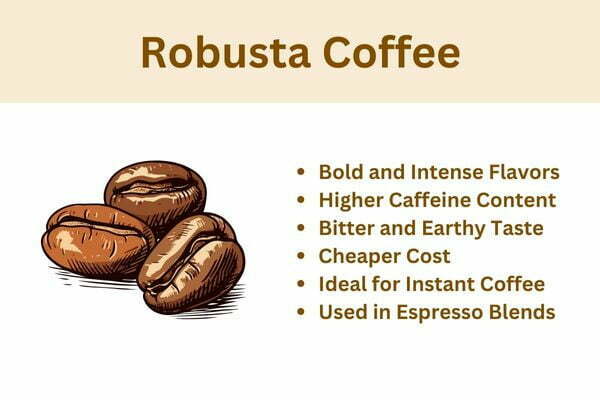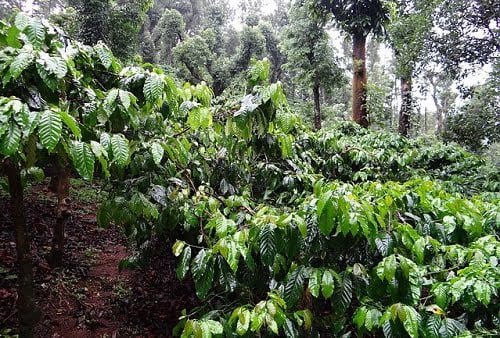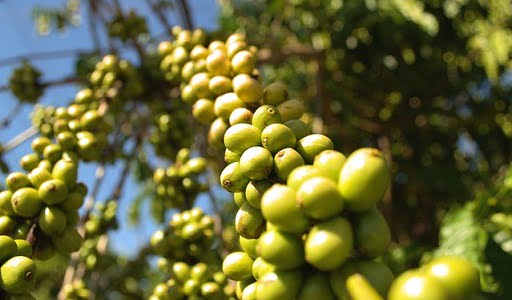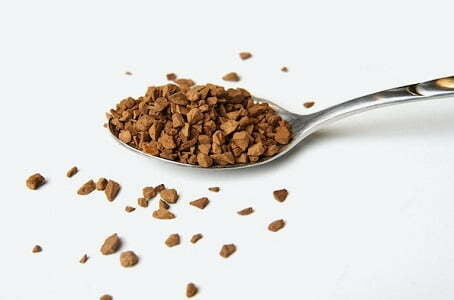Most coffee lovers turn up their noses at the thought of Robusta Beans.
They’ll sing the praises of fruity, floral Arabica all day long. But just like that one friend who’s a bit rough around the edges, Robusta deserves some love too.
Key Takeaways
- Robusta accounts for 40% of global coffee production
- Robusta has a stronger and bolder flavor with bitter undertones
- Robusta beans contain almost double the caffeine of Arabica
- These plants are easier to cultivate and have higher yields
- Main Robusta producers are Vietnam, Brazil, Indonesia, and India
- It is used widely in instant coffee and Espresso coffee blends
- Robusta has great potential both commercially and in specialty coffee
Read on to get the insider scoop on where Robusta Coffee comes from, how it tastes, and why it just might be the ultimate underdog of the coffee world.

What is Robusta coffee?
Robusta is a type of coffee made from the seeds of the Coffea canephora plant. It’s known for having a stronger, bolder, and bitter flavor profile compared to Arabica coffee. Robusta coffee makes up about 40% of the world’s coffee production.
Robusta coffee beans are smaller, rounder, and contain almost twice the caffeine compared to Arabica beans.
Robusta coffee plants have higher yields and greater resilience to pests and diseases. This makes cultivation cheaper and a viable option for instant coffee and budget coffee blends.
What makes Robusta coffee special is its unique flavor profile, ashy undertones, intense boldness, and high caffeine content. Additionally, Robusta is an efficient commercial crop that can be grown cheaply at low altitudes and hot climates.
Also read a Guide on Arabica Coffee beans
Where is robusta coffee grown?
Robusta coffee is primarily grown in tropical regions of Asia and Africa. The main Robusta producing countries are Vietnam, Brazil, Indonesia, and India.
Robusta coffee thrives in warm, tropical environments with high humidity levels and rainfall. It grows best at relatively low altitudes below 2,000 feet.
The ideal conditions for Robusta cultivation include average temperatures around 75-85°F and annual precipitation between 60-100 inches.

Here are the main growing regions of Coffee Robusta:
Vietnam
Vietnam is the second largest producer of coffee in the World and it mainly grows Robusta coffee, accounting for over 18% of global output.
Most production is focused in Vietnam’s central highlands, where the climate and red basalt soil provide excellent conditions for Robusta cultivation.
Brazil
Brazil is mainly known for its Arabica Coffee, however, it is also responsible for over 15% of worldwide Robusta production.
Robusta thrives across many Brazilian states, including Espírito Santo, Rondônia, Bahia, and Rio de Janeiro.
Indonesia
In Indonesia, Robusta is widely grown on the islands of Sumatra and Java, which are major coffee-producing islands.
Indonesia is known for its high-quality Robusta beans with full-bodied flavors and earthy notes.
India
India produces significant quantities of Robusta, largely in the southwestern states of Karnataka and Kerala.
The heavy monsoon rains and optimal temperatures make this coastal region perfect for Robusta cultivation.
Also Read: What Country has the best coffee
What are the Characteristics of Robusta Coffee?
Robusta coffee plants are small trees that can grow up to 10 meters tall, with broad leaves and small white flowers.
The trees begin producing fruit after 3-4 years and reach peak production levels at 8-10 years old.
Robusta cherries take 9-11 months to ripen after flowering. Plants are pruned for optimum fruit yield and can have a productive lifespan of 15-20 years.
Robusta grows well on plantation-style farms with hundreds or thousands of trees planted in rows.

How does Robusta coffee taste?
Robusta is known for its bold, intense flavor that really packs a punch. It often has a grain-like and bitter taste with a strong, harsh acidity, especially compared to the more complex and nuanced flavors of Arabica.
Many people don’t like Robusta as it lacks the sweetness and fruitiness of Arabica coffee and often has burnt or ashy undertones.
Personally, I always prefer Robusta in espresso blends as I don’t mind a little bitterness but I can see why its robust flavor isn’t for everyone!
How much caffeine is in Robusta Beans?
On average, Robusta beans have 18-20 mg/g of caffeine making Robusta a very high caffeine variety of coffee. This is nearly double the 10-12 mg/g caffeine content found in Arabica beans on average.
A typical 8 oz cup of brewed Robusta coffee can have 140-200 mg of caffeine.
The Robusta plant produces such high levels of caffeine as a defense mechanism against insects and pests.
As an Amazon Associate, I earn commission from qualifying purchases.
What are the Top Robusta Coffee Bean brands?
1. Nguyen Coffee Supply
Nguyen Coffee Supply is my top pick for Robusta coffee. They offer a delightful variety of blends.
They get beans from Vietnamese farmers to create unique Robusta-focused blends.
Their Hanoi Peaberry Robusta is my personal favorite – it’s a 100% Robusta with a bold, intense nutty flavor and twice the caffeine kick.
Nguyen is truly changing the future of coffee by showcasing the diversity, sustainability, and flavor of high-quality Robusta.

2. Lavazza Super Crema
Lavazza Super Crema is my go-to for Espresso. It’s a cool blend of 60% Arabica and 40% Robusta.
Lavazza carefully calibrates this ratio to allow the Arabica’s floral, fruity notes to shine while the Robusta adds a bold, creamy backbone.
The result is an impeccably smooth espresso with rich hazelnut and brown sugar aromas.
The Robusta provides just enough punch and thick crema without overwhelming the Arabica’s delicate flavors.

Check out my favorite Espresso beans
Robusta vs Arabica Coffee beans
Robusta vs. Arabica coffee beans are like the yin and yang of the coffee world.
- Robusta beans are known for their intense, bitter taste profile, while Arabica beans are smooth, mild, and fruity.
- The flavor profile of Robusta leans towards earthiness with smoky undertones of wood and nuts. Arabica provides a complex flavor profile including sweet fruity tones to deep chocolaty notes.
- Robusta is hardier, growing at lower altitudes, and is less susceptible to pests and diseases. It’s also more cost-effective to cultivate, making it a preferred choice for mass production. On the flip side, Arabica demands higher elevations, is more fragile, and has a higher production cost.
How to make perfect coffee with Robusta Beans
I find Robusta shines best in intense brew methods like Espresso and French press where you really extract those bold, intense flavors.
The richness also complements nicely with milky drinks like lattes and cappuccinos.
For hot summer days, Cold brew with Robusta beans is a fantastic choice. The lower water temperature in cold brewing extracts fewer bitter compounds, resulting in a smoother and less acidic coffee.
Robusta is also the main ingredient for the famous Vietnamese Iced Coffee drink.
“The perfect balance of bitterness from the robusta beans and sweetness from the condensed milk creates an intricate push-and-pull of flavors.” – bonappetit
For pour-overs, I recommend using a high coffee-to-water ratio – say 1:12 instead of 1:17 – since Robusta contains fewer sugars, so a higher ratio will help extract more of those sugars and make the taste enjoyable.
However, I tend to avoid using Robusta for Pour Overs as it can sometimes lead to an overly bitter taste.
What is Robusta Coffee Used For?
Robusta coffee often gets an undeserved bad rap, but it plays a vital role in the world of coffee
Robusta is commonly used as instant coffee
Robusta coffee has always been the preferred choice for instant coffee.
The freeze-drying process in making instant coffee consumes a large volume of ground coffee to produce a small amount of powder in the end.
Therefore, inexpensive Robusta beans provide an ideal base for making instant coffee on a mass scale.
Additionally, the high caffeine content and bold, bitter taste of Robusta beans can withstand the heat and dehydration of the instant coffee-making process.

Robusta Arabica blends is the essence of Espresso
Robusta has a long history in authentic Italian Espresso blends. Its intense flavor and high caffeine content contribute to the thick crema and bold taste that define a traditional espresso shot.
“Robusta wasn’t just a cost-saving compromise in Italy—it had become a sought-after taste. In Italian coffee brokers’ catalogs in the 1980s, it wasn’t uncommon to see 20 different robustas, each with its own unique profile, priced nearly the same as the arabicas on the list.”- Saveur
It’s also an ideal companion for milk-based espresso drinks like lattes and cappuccinos.
However, with the rise of specialty coffee, many modern espresso blends now use 100% arabica beans, which offer a smoother taste.
The Future of Robusta Coffee
The future of Robusta coffee is looking increasingly promising, driven by several key factors.
As climate change causes trouble for fragile Arabica crops, hardy Robusta is poised to keep on thriving. Rising temperatures and diseases are no match for sturdy Robusta trees. These guys can better handle heat and pests thanks to their natural defenses.
According to Inter American Development Bank:
“Rising temperatures will reduce the area suitable for growing coffee by up to 50% by 2050.“
Plus, Robusta coffee trees are high-yielders, producing many more beans per tree than Arabica. This has helped to drive Robusta’s share of global coffee production up from 25% to 40% over the past few decades.
But it’s not just about quantity with Robusta – quality is making a comeback too. Researchers and coffee companies are working on developing new Robusta varieties with surprisingly delicious flavors using selective breeding and creative processing methods. We’re talking sweet Robustas with chocolate and nutty notes.
World Coffee Research Organization has recently published a report on the Future of Robusta quality.
“For the future, maybe it could be interesting if breeding could change the impact of flavor. Today [the impact of varieties on flavor] is limited. One thing from consumers is [that robusta can be] too bitter. Tomorrow one opportunity is to remove bitterness. Young people like sweet coffee. If we can get sweeter coffee from breeding, from new plants, that is good in future.” – World Coffee Research report
Final Thoughts
After diving deep into all things Robusta, I’ve gained a whole new appreciation for this undervalued bean. It’s easy to dismiss it as bitter and inferior, but Robusta fills vital roles that the coffee world would suffer without.
Its hardy nature, high yields, and low cost make robusta an efficient commercial crop that allows growers to thrive and provides an affordable caffeine boost many rely on.
Yet robusta has specialty potential too with innovative processing enhancing its flavors. Furthermore, robusta’s resilience will be indispensable as Arabica faces challenges from climate change.
I’m excited to keep exploring different robustas and brewing techniques that highlight their diverse flavors. I personally have always enjoyed Robusta-Arabica Coffee blends for rich and thick Espresso shots.
This bean has a bright future!
Check out a guide on different coffee bean varieties
FAQs
Why is Robusta cheaper?
Robusta coffee is cheaper than Arabica because it’s easier and cheaper to cultivate. They yield more coffee per plant, making it a cost-effective choice for many coffee producers. Plus, Robusta beans lack the complex flavors and sweetness that allow Arabica to command premium pricing.
Is Nescafe Robusta?
Nescafe offers both Arabica and Robusta based coffee products. However, as one of the largest instant coffee brands, their products lean heavily towards using Robusta beans.
Are Starbucks beans Robusta?
Nope, Starbucks only uses Arabica beans in their coffee blends – no Robusta! As one of the largest specialty coffee chains, they focus exclusively on higher quality Arabica for all their drinks.




Interesting read on robusta coffee! I Had a wrong idea it was lower quality than arabica. Makes sense it’s better for blends and instant coffee now!
I’m personally not a fan of Robusta’s bitter, woody notes. But I know people who can’t get enough of that intense punch! Different strokes for different folks.
Yeah, 100% Robusta doesn’t taste very pleasant to me either, but some expertly crafted blends are worth trying.
Don’t knock it till you try it! Robusta gets a bad rap, but I actually like its boldness and punch of flavor. It’s perfect for making strong espresso drinks or milky Lattes
Yes, For milky coffee drinks I always use Robusta blends.
I always go for a arabica-robusta blend for espresso shots. I like the balance of bright fruity notes and deep roasted flavors.
Plus the thick crema layer robusta gives is also very delightful!
I’ve always been a die-hard Arabica drinker, but now I’m curious to try a good Robusta on its own — maybe in a Vietnamese iced coffee. Any recs for smooth, less bitter Robusta beans? Also, does the brewing method really make that much of a difference with Robusta?